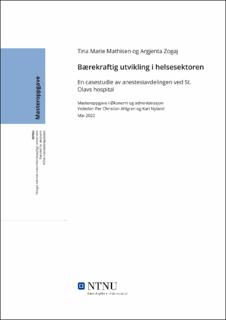| dc.contributor.advisor | Ahlgren, Per Christian | |
| dc.contributor.advisor | Nyland, Kari | |
| dc.contributor.author | Mathisen, Tina Marie | |
| dc.contributor.author | Zogaj, Argjenta | |
| dc.date.accessioned | 2022-09-16T17:20:11Z | |
| dc.date.available | 2022-09-16T17:20:11Z | |
| dc.date.issued | 2022 | |
| dc.identifier | no.ntnu:inspera:112632672:113031295 | |
| dc.identifier.uri | https://hdl.handle.net/11250/3018594 | |
| dc.description.abstract | “Forandring er tvingende nødvendig!” skrev Brundtland i Vår felles framtid om bærekraftig utvikling i 1987 (Brundtland, 1987, s.9). Norges svar på å stanse klimaendringene har utviklet seg til å bli et overordnet mål om å redusere klimagassutslippet med minst 50% innen 2030 (Klima- og miljødepartementet, 2021; FN-sambandet, 2020). I denne masteroppgaven undersøker vi hvordan et stort, norsk, offentlig sykehus bidrar til å forhindre klimaendringene. Oppgaven har hatt til hensikt å svare på følgende problemstilling:
Hvordan brukes styringssystemer i arbeidet for en bærekraftig utvikling i helsesektoren?
For å kunne svare på problemstillingen har vi fokusert på redusering av anestesigassen Desfluran på anestesiavdelingen ved St. Olavs hospital. Vi har gjennomført en kvalitativ casestudie med datamateriale fra et omfattende dokumentstudie, samt syv dybdeintervjuer. Informantene er hovedsakelig valgt ut ifra det strategiske- og operative nivået, til hensikt å få et bredere bilde av praksisen. Problemstillingen besvares gjennom to tilnærminger før vi diskuterer teorienes sammenheng. Disse to tilnærmingene er Simons (1995a) Levers of Control og institusjonell teori (Meyer & Rowan 1977, DiMaggio & Powell, 1983).
Blant helseforetakene viser funnene våre at St. Olavs hospital er største forbrukeren av Desfluran, den mest miljøfiendtlige anestesigassen (Grønt sykehus, 2022). I tillegg viser empirien at fra 2019-2021 har St. Olavs hospital redusert Desfluran tregere enn landsgjennomsnittet. Videre har oppgaven vår tydet at styringssystemene fra det strategiske nivået ikke ser ut til å gjennomsyre organisasjonen. Det virket ikke som om det operative nivået får bærekraftsstrategier kommunisert tilstrekkelig, slik at de ikke blir bevisst over de planene det strategiske nivået har for organisasjonen. Fra Simons (1995a) ser vi særlig at det er mangel på interaktivt styringssystem, men også grensesettende styringssystem. Dette kan være en forklaring på hvorfor bærekraftig utvikling dekobles fra det strategiske nivået til det operative nivået. I et institusjonelt perspektiv har vi sett at det kan ha oppstått dekobling i mellomledelsen da empirien har vist et bærekraftig initiativ fra både toppledelsen og det operative nivået. De organisatoriske nivåene er bare ikke samkjørt. I tillegg diskuterer vi hvorvidt den reduksjonen som har oppstått skyldes normativ isomorfisme på avdelingsnivå, da ildsjeler har klart å dra arbeidspraksisen i en mer bærekraftig retning. Dette førte til at bærekraftsarbeidet på avdelingsnivå skapte oppmerksomhet fra omgivelsene, og bidro til å presse helsesektoren i en grønnere omstilling. | |
| dc.description.abstract | “Change is urgently needed!” Brundtland wrote in Our Common Future on Sustainable Development in 1987. Norway's response to halting climate change has developed into an overarching goal of reducing greenhouse gas emissions by at least 50% by 2030 (Klima- og miljødepartementet, 2021; FN-sambandet, 2020). In this master's thesis, we investigate how a large, Norwegian, public hospital contributes to preventing climate change. The thesis has intended to answer the following issue:
How are management control systems used in working towards a sustainable development in the health sector?
To be able to answer the issue, we have focused on reducing the anesthetic gas ‘Desfluran’ in the anesthesia department at St. Olavs hospital. We have conducted a qualitative case study with data material from a comprehensive document study, as well as seven in-depth interviews. The informants are mainly selected on the strategic and operational level, with the intention of gaining a broader picture of our case. The problem is answered through two approaches before we discuss the context of the theories. These two approaches are Simons' (1995a) Levers of Control and Institutional Theory (Meyer and Rowan 1977; DiMaggio & Powell, 1983).
Among the hospitals, our findings show that St. Olavs hospital is the largest user of Desfluran, the most environmentally hostile anesthetic gas (Grønt sykehus, 2022). In addition, empirical evidence shows that from 2019-2021, St. Olavs hospital has reduced Desfluran more slowly than the national average. Furthermore, our task has indicated that the management systems from the strategic level do not seem to permeate the organization. It did not seem like the operational level was aware of the sustainability strategies due to lack of communication. From Simons (1995a) we see in particular that there is a lack of an interactive control system, but also a boundary-setting control system. This may be an explanation as to why sustainable development is decoupled from the strategic level to the operational level. From an institutional perspective, we have seen that there may have been a decoupling in the middle level management as the empirical evidence has shown a sustainable initiative from both the top management and the operational level. The organizational levels are just not aligned. In addition, we discuss whether the reduction that has occurred is due to normative isomorphism at the departmental level, as passionate individuals have managed to pull work practices in a more sustainable direction. This led to the sustainability work at departmental level creating attention from the environment, and contributed to pushing the health sector in a greener transition. | |
| dc.language | nob | |
| dc.publisher | NTNU | |
| dc.title | Bærekraftig utvikling i helsesektoren | |
| dc.type | Master thesis | |
